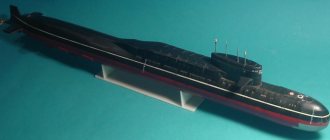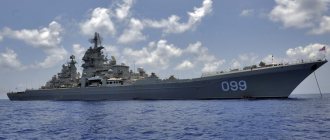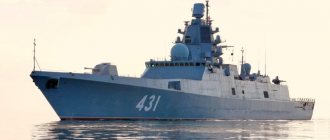Project 613 - a submarine with the simplicity and reliability of a “three-line” rifle
On March 13, 1950, the lead submarine of Project 613 was laid down: the most massive submarine of the Russian fleet.
The experience of the Great Patriotic War clearly showed what a colossal role submarines play in combat operations on the seas and oceans. The Soviet Union entered the war with only 218 submarines in its Workers' and Peasants' Red Fleet—almost half the size of Germany's submarine force in 1943, at its peak: 432 boats. And a new, this time “cold” war that broke out shortly after the Victory required a sharp increase in the number of submarines also because they constituted a significant part of the strike forces of Russia’s main geopolitical opponent, the United States.
But our country, exhausted and drained of blood by a difficult war, could quickly pump up its “underwater muscles” in only one way: by following the example of a defeated enemy. It was no secret that in its best years, the German shipbuilding industry launched almost one submarine every two days. This means that it was possible and necessary to take advantage of this experience and establish our own production of submarines using the in-line method. And this meant, among other things, the need to carefully study - and possibly modify to suit your needs - the designs of German submarines.
Most likely, it was precisely these considerations that guided the Navy command when, at the end of 1944, it ordered the suspension of work on the new project of the Soviet medium submarine, code 608, and to begin analyzing the captured boats of the VII and XXI series. This took a year and a half: only in January 1946, the Main Command of the Soviet Navy approved a new technical specification for the development of the boat - thus Project 613 was born. Two years later, on August 15, 1948, the technical design of the new submarine was approved by the government, and on March 13 In 1950, the first diesel-electric submarine of Project 613, S-80 (order 801), was laid down in Gorky. A little over seven months later, on October 21, three-quarters of the finished boat was launched and placed at the outfitting wall, and already on November 1, the S-80 arrived in Baku, where, after additional equipment, it underwent sea trials from December 31, 1950 to April 26, 1951 . Finally, on July 9, the boat made a control deep-sea dive, and on December 2, the state commission signed an acceptance certificate. By this time, another lead submarine of Project 613, the S-61, was already being completed at the Black Sea Shipyard in Nikolaev. She was laid down on April 11, 1950, launched on July 22, put out for mooring trials on January 12, 1951, then transferred to Sevastopol and put into service on May 24, 1952.
In total, in the entire history of Project 613, 215 submarines were built in seven years - from 1950 to 1957. This made the submarines of this series the most numerous in the Soviet fleet in the entire history of its existence. However, there could have been more boats: according to the original plan, as many as 340 units were going to be built! But while the construction of the first hundred boats was underway, new, more modern projects appeared, which were quickly brought to mass production, and as a result, the 613th project was limited to just over two hundred boats. 116 of them were built by the Gorky plant, 72 by the plant in Nikolaev, 16 by the Baltic plant named after Sergo Ordzhonikidze in Leningrad and 11 by the Lenin Komsomol plant in Komsomolsk-on-Amur.
In fact, during the years of the most active construction of Project 613 boats, the Soviet fleet received one new submarine of this type every five days! And such unprecedented production rates were achieved through significant rationalization and technologization of boat construction. For the first time in domestic practice, the flow-sectional construction method, automatic welding and radiographic inspection of welds were widely used in the construction of submarines. In addition, the speed of construction was also affected by the fact that the developers of Project 613, together with production workers, achieved maximum unification of product parts and materials, made full use of aggregation (that is, the geometric and functional interchangeability of individual elements and assemblies) when assembling mechanisms and devices and managed to practically get rid of Traditional at that time, manual fitting of elements during installation.
Modifications of Project 613 submarines. Photo: www.deepstorm.ru
After this, is it any wonder that in the shortest possible time the Soviet fleet not only managed to build up its “underwater muscles”, but also received at its disposal a boat that enjoyed good fame among submariners. Suffice it to say that out of 215 submarines, only two were lost - a rare result for any fleet in the world!
What were the “six hundred and thirteenth”? These were simple, one might even say, somewhat primitive submarines of a classic double-hull design, with three shelter compartments, ten main ballast tanks, and two 2000 hp diesel engines. each and two electric motors of 1350 hp. Diesels accelerated the boat to a speed of 18.5 knots and allowed it to travel up to 8,500 miles on the surface. Powered by electric motors, Project 613 boats could travel submerged at a maximum speed of 13.1 knots, and the battery range was 352 miles. All boats were armed with six 533 mm torpedo tubes - four bow and two stern. By the way, the torpedoes that the 613th were armed with could also have had nuclear warheads. In addition, the boats of the first series also had artillery weapons: the obligatory 25-mm twin 2M-8 anti-aircraft gun in the front fence of the wheelhouse, and some also had a universal twin artillery mount SM-24-ZIF of 57 mm caliber, which was located behind the wheelhouse. But gradually the guns and artillery guns were abandoned, which made it possible to reduce the crew from 53 to 52 people (of which 10 were officers), and most importantly, to increase the underwater speed due to better streamlining of the hull.
Project 613 boats earned genuine respect from Soviet submariners not only for their reliability and ease of use and control, but also for their unpretentiousness. Even if these submarines were not the best in the world, and were not even the best in Russia, they made it possible to quickly restore the submarine fleet and do this without making superhuman efforts and without diverting human resources to too complex training of personnel. In this sense, the “six hundred and thirteenth” were very similar to the Mosin “three-line” rifle: although it was not the best in the world, it best met the requirements and capabilities of the Russian army, due to which it remained in service for almost a century.
The same fate was in store for the Project 613 submarines. They were in service until 1990, and the last of them were scrapped in 1991. For example, out of 54 Project 613 submarines that were part of the 14th Submarine Division of the USSR Black Sea Fleet, 18 submarines remained in service in 1990, most of which were built in 1954-56. By the way, it was the Project 613 boats from the 14th Division that were the same submarines for which the famous “Object 825” was built in Balaklava (the headquarters of the division and two brigades of its composition were located there) - an underground base with a passage channel designed to shelter boats in the event of a nuclear attack, and also included an arsenal of atomic weapons and a protected division command post with a special communications center.
And it was the “613” that became the first Russian submarines to enter the international market. In 1954, working drawings and technical documentation for Project 613 submarines were transferred to China, for which the first three boats of the “Chinese” series were built in the Soviet Union, then disassembled and transported to the Chinese shipyard in Shanghai and launched there. In addition, 12 Project 613 submarines were transferred to Indonesia, 10 to Egypt, four flew under the flag of Albania, the same number served in the navies of the DPRK and Poland, three in Syria, two in Bulgaria, and one in Cuba. In NATO, these most famous Soviet submarines earned the code name “Whiskey” - which, oddly enough, also emphasized their massiveness and prevalence. And the headaches of Western sailors, unexpectedly faced with the massive presence of Russian submarines in the World Ocean, were no worse off from these meetings...
According to trophy drawings
After the Great Patriotic War, the Soviet fleet, which had lost more than a third of its submarines in battle, was in dire need of replenishment. At the same time, the task was not only to make up for losses, but also to build new models. The “Pikes” (a series of medium diesel-electric submarines produced since 1930) that were in service with the USSR Navy were already outdated by that time and were much inferior to foreign boats in terms of diving depth and torpedo firing capabilities.
Pike-class submarine of the Black Sea Fleet, 1944
Image source: © Ministry of Defense of the Russian Federation
Domestic engineers were able to get acquainted with world achievements in this area thanks to German, British and American submarines. Some were captured, others received under Lend-Lease.
Having studied foreign models, Soviet engineers began creating new boats within the framework of Project 613, which allowed the Navy to strengthen the country’s borders in the difficult post-war period.
"Swedish Komsomolets"
The navy jokingly called the S-363 boat of Project 613 “Swedish Komsomol member”. The ironic nickname appeared as a result of an incident that occurred on October 27, 1981 in Swedish territorial waters.
Project 613 submarine S-363 during a rescue operation off the coast of Sweden, 1981
Image source: © Marinmuseum/CC BY 4.0
The official TASS report said: “On the night of October 27-28, a Soviet diesel submarine with tail number 137, making a routine training voyage in the Baltic Sea, due to the failure of navigation instruments and the resulting errors in determining the location in poor visibility lost her course and ran aground off the southeastern tip of Sweden. The submarine has now been refloated by Swedish rescue vessels and is anchored in a safe location. Negotiations are underway with the Swedish authorities to remove the submarine from Swedish territorial waters.”
Subsequently, according to one version, the decommissioned boat remained in Sweden and was exhibited in one of the museums of military equipment.
Reliable as a Mosin rifle, strong as whiskey
According to reserve captain 1st rank Nikolai Chernyshev, who served on one of the Project 613 boats, the main tasks of the 613 crews were: launching torpedo attacks on enemy warships and vessels, laying mines, and landing sabotage groups on the enemy’s coast.
Director of the museum "PL S-189" Nikolai Chernyshev
Image source: © Yuri Belinsky/TASS
For reliability, ease of operation and multi-purpose use, submariners compared Project 613 submarines with Mosin rifles. In the American classification, the submarine was called Whiskey. According to military historians, this nickname was assigned to the Soviet boat for its robust design (with an all-welded hull of enhanced strength), as well as for its mass production and prevalence. More than 40 Project 613 boats were exported.











